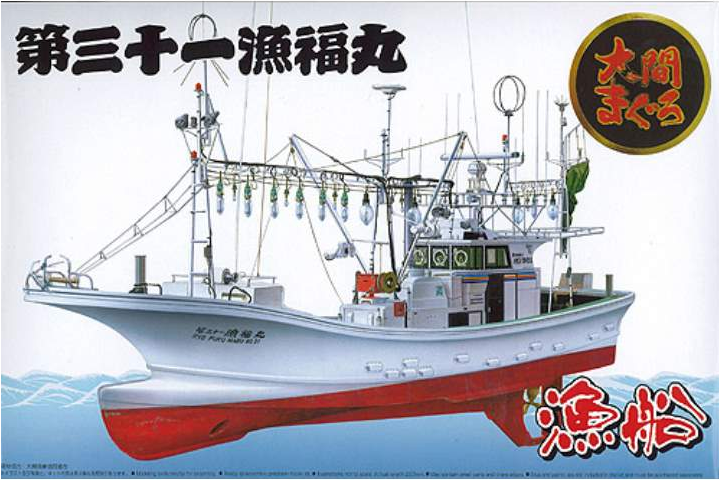Ooma's Tuna Fishing Boat "Ryoufuku-maru #31"
Introduction
If you're looking to change things up a little from the armor or naval vessels or historical military aircraft kits you've been building, what about a tuna fishing boat for a change of pace? Aoshima of Japan is offering just such a kit with "Ryoufuku-maru #31". Tuna fishing is the main industry in the north of the island of Honshu, Japan and Aoshima offers this kit of the boat that makes it all possible. The boat depicted by this kit is representative of the typical tuna fishing boat this industry is built around.
My thanks go out to Dragon Models USA for providing this Aoshima kit for review and to IPMS USA for letting me review it.
In the Box
The kit has a total of about 375 finely molded parts (don't panic, 132 of those are floats) on 10 sprues, instructions, a decal sheet and a thin sheet of tissue paper with double-sided, celebratory flags printed on it. There is also a tree of nylon bushings that are used to hold the hull halves (top & bottom together) and a length of thread to be used for the floats. 3 parts go to building a scale fisherman and 2 other parts build what looks like a scale Pacific Blue fin tuna.
The injection molded parts are crisply and cleanly done with excellent detail and no residual flash. With all the antennae, rigging, conduit and railing however, there are a lot of molding 'tabs' to remove and clean up after but this is not a real problem. The 132 floats are molded in yellow plastic but so clean that the thread feeds through them with no effort at all. There are 2 identical "I" sprues of different sized light housings- only 1 full sprue is needed and one part off the other is required.
The instructions are nicely done, printed in Japanese with an English translation. They are well organized, easy to follow and nicely detailed. The paint color call-outs and decal placement are integrated into the right places in each step. Essentially, you are guided through building the hull, then the cabin and finally the superstructure and details in 3 subassemblies.
Decals are included for external cabin striping, naming and radio call-signs - nice and simple. These decals are small but tough enough to be moved around and positioned on the cabin with a knife or toothpick.
The flags are designed to be cut out, glued and folded in half, around the 'bamboo' masts. The paper is similar to the tissue paper we all used on our balsa wood model airplanes back in the day.
Construction/Finishing
Construction and finishing of the Fuku Maru was straightforward. As mentioned above, you'll be guided through building up the hull, then the cabin and finally the conduit and railing superstructure in subassemblies. The order works well to allow the modeler to paint, apply decals and weather the boat as desired before putting the subassemblies together with glue. The cabin was dry fit in place on the hull which allowed the superstructure to be built in place with the support of the deck and the cabin to hold everything in place while the glue set. I chose to finish and weather it as it might appear having just returned from many days at sea using weathering powders and a small applicator sponge.
With the superstructure complete and painted, I turned it upside down and supported on clothes pins in order to put the centerline lanterns on the superstructure. Good thing they included two sets of sprue "I" because these light housings are small and will shoot right across the room if you're not holding on to them when you clip them from the sprue (you'll be glad you have the extras).
A note about the decals... unless you read Japanese, pay attention to the orientation of the decals - make sure you know which side is up. Also, the port side bow decal is 'different' than the starboard side decal so make sure to get it right.
Conclusions
A modern tuna boat is a little off the usual topic but this was a challenging, accurate and fun kit to build. I highly recommend Aoshima's Fuku Maru #31 tuna boat kit for modelers of any experience level. Even though it will be a little tough for beginners, they will still have fun with it and the finished model looks great. If you do a little research on the web you can even learn something about the unique fishing culture of northern Japan. This was a really fun build and a nice change-of-pace subject.
Again, I want to thank Dragon Models USA, Inc. for providing this Aoshima kit and IPMS/USA for the opportunity to review it.


















Comments
Add new comment
This site is protected by reCAPTCHA and the Google Privacy Policy and Terms of Service apply.
Similar Reviews